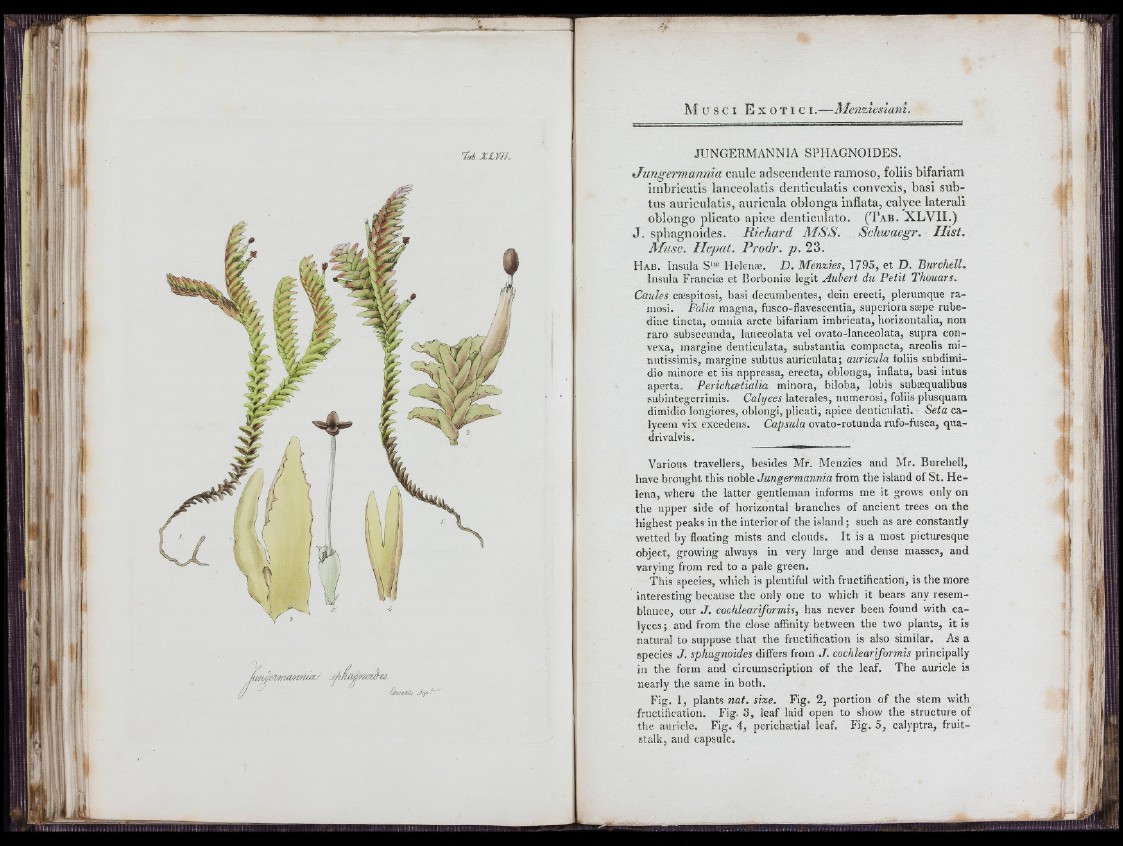
7at XlVìh JUNGERMANNIA SPHAGNOIDES.
Jungermannia caule adscendente ramoso, foliis bifariam
imbricatis lanceolatis denticulatis convexis, basi subtus
auriculatis, auricula oblonga infiata, calyce laterali
obiongo plicato apice denticulato. ( T a b . XLVII.)
J. spbagnoides. Richard M S S . Schwaegr. H ì s t .
A'Iiisc. Ilepat. Prodr. p . 23.
H a b . Insula S'“ Ilelenæ. D. Menzies, 1795, et D. Burchell.
Insula Francise et Borboniæ legit Auhert du Petit Tliouars.
Caules cæspitosi, basi decumbentes, dein erecti, plerumque ramosi.
F'oHa magna, fusco-flavescentia, superiora sæpe rube-
dine tincta, omnia arcte bifariam imbricata, horizontalia, non
raro subsecunda, lanceolata vel ovato-lanceolata, supra con-
vexa, margine denticulata, substantia compacta, areolis minutissimis,
margine subtus auriculata; auricula foliis subdimi-
dio minore et iis appressa, erecta, oblonga, infiata, basi intus
aperta. Perichcetialia minora, biloba, lobis subæqualibus
subintegerrimis. Calyces latérales, numerosi, foliis plusquam
dimidio longiores, oblongi, plicati, apice denticulati. Seta ca-
lycem vix excedens. Capsula ovato-rotunda rufo-fusca, quadrivalvis.
Various travellers, besides Mr. Menzies and Mr. Burchell,
bave brought this noble Jungermannia from the island of St. Helena,
where the latter gentleman informs me it grows only on
the upper side of horizontal branches of ancient trees on the
highest peaks in the interior of the island ; such as are constantly
wetted by floating mists and clouds. It is a most picturesque
object, growing always in very large and dense masses, and
varying from red to a pale green.
This species, which is plentiful with fructification, is the more
interesting because the only one to which it bears any resemblance,
our J . cochleari/ormis, has never been found with calyces;
and from the close affinity between the two plants, it is
natural to suppose that the fructification is also similar. As a
species J . sphagnoides differs from J . cochleariformis principally
in the form and circumscription of the leaf. The auricle is
nearly the same in both.
Fig. 1, plants nat. size. Fig. 2, portion of the stem with
fructification. Fig. 3, leaf laid open to show the structure of
the auricle. Fig, 4, perichætial leaf. Fig. 5, calyptra, fruitstalk,
and capsule.
I l l
:i I
I I
] I
11
IlijI